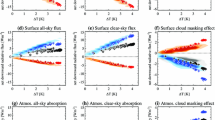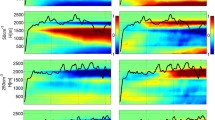Abstract
The possibility of applying either the maximum entropy production conjecture of Paltridge (Q J R Meteorol Soc 101:475–484, 1975) or the conjecture of Lorenz (Generation of available potential energy and the intensity of the general circulation. Pergamon, Tarrytown, 1960) of maximum generation of available potential energy (APE) in FAMOUS, a complex but low-resolution AOGCM, is explored by varying some model parameters to which the simulated climate is highly sensitive, particularly the convective entrainment rate, \(\epsilon\), and cloud droplet-to-rain-conversion rate, c T . The climate response is analysed in terms of its entropy production and the strength of the Lorenz energy cycle. If either conjecture is true, the parameter values which yield the most realistic climate will also maximise the relevant quantity. No maximum is found in the total material entropy production, which is dominated by the hydrological cycle and tends to increase monotonically with global-mean temperature, which is not constant because the parameter variations affect the net input of solar radiation at the top of the atmosphere (TOA). In contrast, there is a non-monotonic, peaked behaviour in the generation of APE and entropy production associated with kinetic energy dissipation, with the standard FAMOUS values for \(\epsilon\) and c T occurring nearly at the maximising ones. The maximum states are shown to be states of vigorous baroclinic activity. The peak in the generation of APE appears to be related to a trade-off between the mean vertical stability and horizontal stratification. Experiments are repeated for a simplified setup in which the net solar input at TOA is fixed. Again a peak in the generation of APE is found in association with the maximum baroclinic activity, but no trade-off of the kind shown by simple climate models is found between meridional heat transport and the meridional temperature gradient. We conclude that the maximum entropy production conjecture does not hold within the climate system when the effects of the hydrological cycle and radiative feedbacks are taken into account, but our experiments provide some evidence in support of the conjecture of maximum APE production (or equivalently maximum dissipation of kinetic energy).













Similar content being viewed by others
References
Allen MR, Ingram WJ (2002) Constraints on future changes in climate and the hydrological cycle. Nature 419:224–232
Ambaum MHP (2010) Thermal physics of the atmosphere. Wiley, Chichester, 256pp
Bejan A, Lorente S (2004) The constructal law and the thermodynamics of flow systems with configuration. Int J Heat Mass Transf 47:3203–3214
Boer GJ, Lambert S (2008) The energy cycle in the atmospheric model. Clim Dyn 30:371–390
Cullen MJP, Davies T (1991) A conservative split-explicit integration scheme with fourth order horizontal advection. Q J R Meteorol Soc 117:993–1002
Dewar RC (2005) Maximum entropy production and the fluctuation theorem. J Phys A 38:L371–L381
Dewar RC (2009) Maximum entropy production as an inference algorithm that translates physical assumption into macroscopic predictions: don’t shoot the messenger. Entropy 11:931–944
Edwards JM, Slingo A (1996) Studies with a flexible new radiation code. part one: choosing a configuration for a large-scale model. Q J R Meteorol Soc 122:689–719
Egger J (1999) Numerical generation of entropies. Mon Weather Rev 127:2211–2216
Fraedrich K, Lunkeit F (2008) Diagnosing the entropy budget of a climate model. Tellus A 60(5):921–931
Fraedrich K, Jansen H, Kirk E, Luksch U, Lunkeit F (2005) The planet simulator: towards a user friendly model. Meteorol Z 14:299–304
Fraedrich K, Kirk E, Luksch U, Lunkeit F (2005) The portable university model of the atmosphere (PUMA): storm track dynamics and low-frequency variability. Meteorol Z 14:735–745
Goody R (2000) Sources and sinks of climate entropy. Q J R Meteorol Soc 126:1953–1970
Goody R (2007) Maximum entropy production in climate theory. J Atmos Sci 64:2735–2739
Gordon C, Cooper C, Senior CA, Banks H, Gregory JM, Johns TC, Mitchell JFB, Wood RA (2000) The simulation of SST, sea ice extents and ocean heat transports in a version of the Hadley Centre coupled model without flux adjustments. Clim Dyn 16:147–168
Grassl H (1981) The climate at the maximum-entropy production by meridional atmospheric and oceanic heat fluxes. Q J R Meteorol Soc 107:153–166
Gregory D (1995) A consistent treatment of the evaporation of rain and snow for use in large-scale models. Mon Weather Rev 123:2716–2732
Gregory D (1998) Unified model documentation paper no. 28. Technical report, Meteorological Office
Gregory D, Rowntree PR (1990) A mass flux convection scheme with representation of cloud ensemble characteristics and stability-dependent closure. Mon Weather Rev 118:1483–1506
Grinstein G, Linsker R (2007) Comments on a derivation and application of the maximum entropy production principle. J Phys A 40:9717–9720
Hernández-Deckers D, Von Storch J (2009) Energetics responses to increases in greenhouse gas concentration. J Clim 23:3874–3887
Hoskins BJ, Valdes PJ (1990) On the existence of storm-tracks. J Atmos Sci 47(15):1854–1864
James IN (1994) Introduction to circulating atmosphere. Cambridge University Press, Cambridge
Johnson DR (1997) “General Coldness of Climate Models” and the second law: implications for modelling the earth system. J Clim 10:2826–2846
Jones C, Gregory J, Thorpe R, Cox P, Murphy J, Sexton D, Valdes P (2005) Systematic optimisation and climate simulation of FAMOUS, a fast version of HadCM3. Clim Dyn 25:189–204
Kleidon A (2004) Beyond gaia: thermodynamic of life and earth system functioning. Clim Change 66:271–319
Kleidon A (2005) Hyperdiffusion, maximum entropy production, and the simulated equator-pole temperature gradient in an atmospheric general circulation model. http://hdl.handle.net/1903/1927
Kleidon A (2009) Nonequilibrium thermodynamics and maximum entropy production in the earth system. Naturwissenschaften 96:653–677
Kleidon A (2010) Life, hierarchy and the thermodynamic machinery of planet Earth. Phys Life Rev (in press)
Kleidon A, Fraedrich K, Kunz T, Lunkeit F, (2003) The atmospheric circulation and the states of maximum entropy production. Geophys Res Lett 30(23)
Kleidon A, Fraedrich K, Kirk E, Lunkeit F (2006) Maximum entropy production and the strenght of boundary layer exchange in an atmospheric general circulation model. Geophys Res Lett 33(L06706):4. doi:10.1029/2005GL025373
Kunz T, Fraedrich K, Kirk E (2008) Optimisation of simplified GCMs using circulation indices and maximum entropy production. Clim Dyn 30:803–813
Lorenz EN (1955) Available potential energy and the maintenance of the general circulation. Tellus 7:271–281
Lorenz EN (1960) Generation of available potential energy and the intensity of the general circulation. Pergamon, Tarrytown
Lorenz EN (1967) The nature and theory of the general circulation of the atmosphere, volume 218.TP.115. World Meteorological Organization
Lorenz RD, Lunine JI, Withers PG, McKay CP (2001) Titan, mars and earth: entropy production by latitudinal heat transport. Geophys Res Lett 28(3):415–418
Lucarini V (2009) Thermodynamic efficiency and entropy production in the climate system. Phys Rev E 80:021118. doi:10.1103/PhysRevE.80.02118
Lucarini V, Fraedrich K, Lunkeit F (2010) Thermodynamic analysis of snowball earth hysteresis experiment: efficiency, entropy production and irreversibility. Q J R Meteorol Soc 136:1–11
Lucarini V, Fraedrich K, Lunkeit F (2010b) Thermodynamics of climate change: generalized sesnitivities. Atmos Chem Phy 10:9729–9737. doi:10.5194/acp-10-9729-2010
Malkus WVR (2003) Borders of disordrs: in turbulent channel flow. J Fluid Mech 489:185–198
Martyushev LM, Seleznev VD (2006) Maximum entropy production principle in physics,chemistry and biology. Phys Rep 426:1–45
Murakami S, Kitoh A (2005) Euler-lagrange equation of the most simple 1-D climate model based on the maximum entropy production hypothesys. Q J R Meteorol Soc 131(608):1529–1538
Murphy JM, Sexton DMH, Barnett DN, Jones GS, Webb MJ, Collins M, Stainforth DA (2004) Quantification of modelling uncertainties in a large ensemble of climate change simulations. Nature 430:768–772
Noda A, Tokioka T (1983) Climates at minima of the entropy exchange rate. J Meteorol Soc Jpn 61:894–908
Odum HT (1988) Self-organization, transformity and information. Sci Agric 242:1132–1139
O’Gorman PA, Schneider T (2008) Energy of midlatitude transient eddies in idealized simulations of changed climates. J Clim 21:5797–5808. doi:10.1175/2008JCLI2099.1
Ozawa H, Ohmura A (1997) Thermodynamics of a global-mean state of the atmosphere: a state of maximum entropy increase. J Clim 10:441–445
Ozawa H, Ohmura A, Lorenz R, Pujol T (2003) The second law of thermodynamics and the global climate system: a review of the maximum entropy production principle. Rev Geophys 41(1018):24. doi:10.1029/2002RG000113
Paltridge GW, Farquhar GD, Cuntz M (2007) Maximum entropy production, cloud feedback, and climate change. Geophys Res Lett 34(L14708):6. doi:10.1029/2007GL029925
Paltridge GW (1975) Global dynamics and climate-a system of minimum entropy exchange. Q J R Meteorol Soc 101:475–484
Paltridge GW (1978) The steady state format of global climate. Q J R Meteorol Soc 104:927–945
Paltridge GW (2001) A physical basis for a maximum of thermodynamic dissipation of the climate system. Q J R Meteorol Soc 127:305–313
Pascale S, Gregory JM, Ambaum M, Tailleux R (2009) Climate entropy budget of the HadCM3 atmosphere-ocean general circulation model and FAMOUS, its low-resolution version. Clim Dyn. doi:10.1007/s00382–009–0718–1
Pauluis O, Held IM (2002a) Entropy budget of an atmosphere in radiative-convective equilibrium. Part I: maximum work and frictional dissipation. J Atmos Sci 59:125–139
Pauluis O, Held IM (2002b) Entropy budget of an atmosphere in radiative-convective equilibrium. Part II: latent heat transport and moist processes. J Atmos Sci 59:140–149
Peixoto JP, Oort AH, de Almeida M, Tomé A (1991) Entropy budget of the atmosphere. J Geophys Res 96(D6):10981–10988
Pope VD, Gallani ML, Rowntree PR, Stratton RA (2000) The impact of new physical parametrizations in the Hadley Centre climate model–HadAM3. Clim Dyn 16:123–146
Pujol T, Fort J (2002) States of maximum entropy production in a one-dimensional vertical model with convective adjustments. Tellus A 54:363–369
Reichler T, Kim J (2008) How well do coupled models simulate today’s climate?. Bull Am Meteorol Soc 89:303–311
Rodgers CD (1976) Minimum entropy exchange principle-reply. Q J R Meteorol Soc 102:455–457
Schneider T, O’Gorman PA, Levine XJ (2010) Water vapor and the dynamics of the climate changes. Rev Geophys 48(RG3001):22. doi:10.1029/2009RG000302
Schulman LL (1977) A theoretical study of the efficiency of the general circulation. J Atmos Sci 34:559–580
Siegmund P (1994) The generation of available potential energy, according to Lorenz’ exact and approximate equations. Tellus 46(A):566–582
Smith RNB (1990) A scheme for predicting layer clouds and their water content in a general circulation model. Q J R Meteorol Soc 116:435–460
Smith RNB (1993) Unified model documentation paper no. 24. Technical report, Meteorological Office
Smith RS, Gregory JM, Osprey A (2008) A description of the FAMOUS (version xdbua) climate model and control run. Geosci Model Develop 1:147–185
Tailleux R (2010) Entropy versus APE production: on the buoyancy power input in the oceans energy cycle. Geophys Res Lett 37(L22603). doi:10.1029/2010GL044962
Volk T, Pauluis O (2010) It is not the entropy you produce, rather, how you produce it. Philos Trans R Soc B 365:1317–1322. doi:10.1098/rstb.2010.0019
Wang B, Nakajima T, Shi G (2008) Cloud and water vapor feedbacks in a vertical energy-balance model with maximum entropy production. J Clim 21(24):6689–6698
Acknowledgments
Salvatore Pascale thanks Robin Smith for the help provided with FAMOUS experiments and Valerio Lucarini for helpful comments. Jonathan Gregory is supported by the NCAS-Climate Programme and the Joint DECC and Defra Integrated Climate Programme, DECC/Defra (GA01101).
Author information
Authors and Affiliations
Corresponding author
Rights and permissions
About this article
Cite this article
Pascale, S., Gregory, J.M., Ambaum, M.H.P. et al. A parametric sensitivity study of entropy production and kinetic energy dissipation using the FAMOUS AOGCM. Clim Dyn 38, 1211–1227 (2012). https://doi.org/10.1007/s00382-011-0996-2
Received:
Accepted:
Published:
Issue Date:
DOI: https://doi.org/10.1007/s00382-011-0996-2




